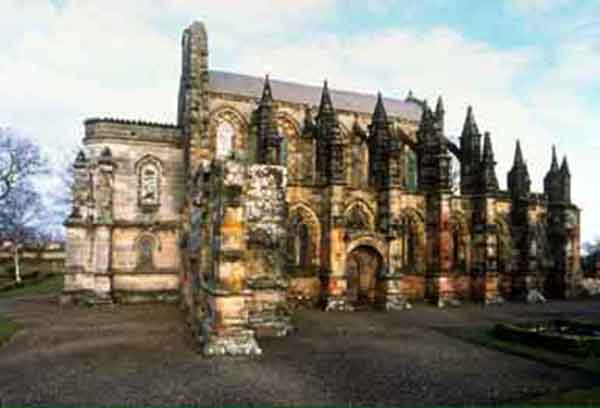


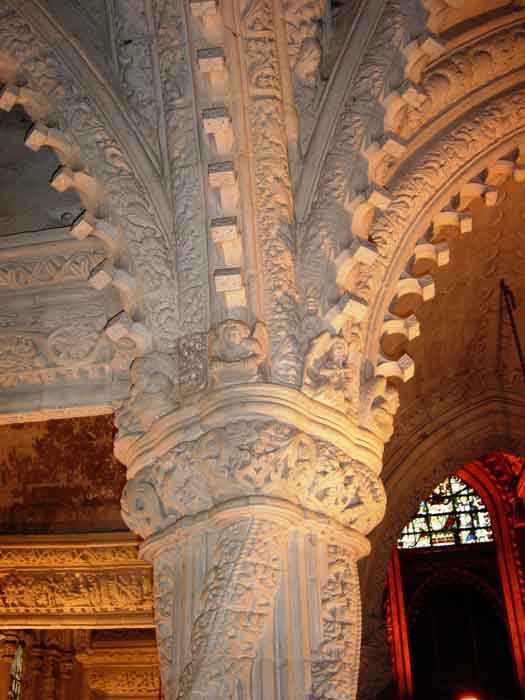
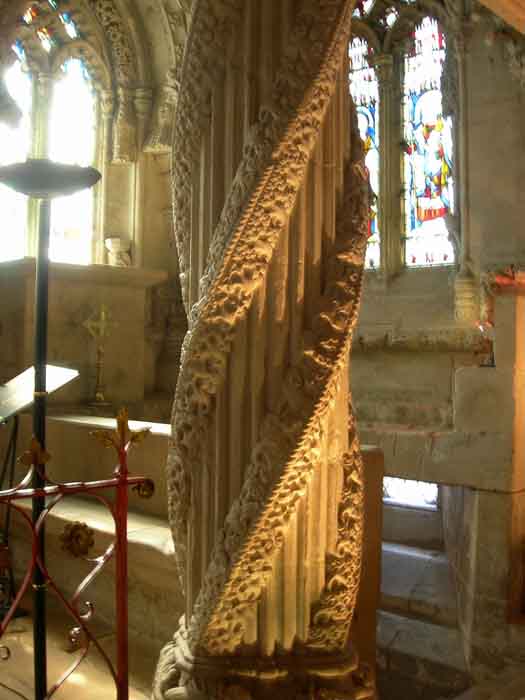
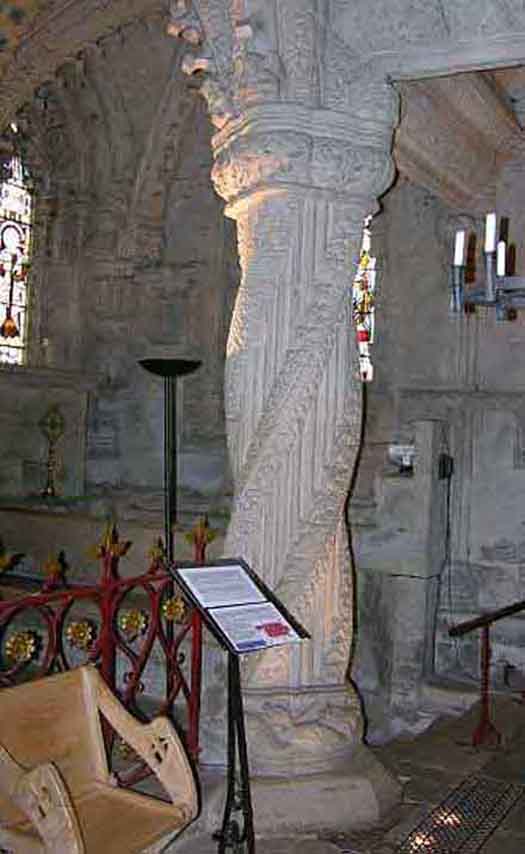
Spiraling Column

The Ouroboros
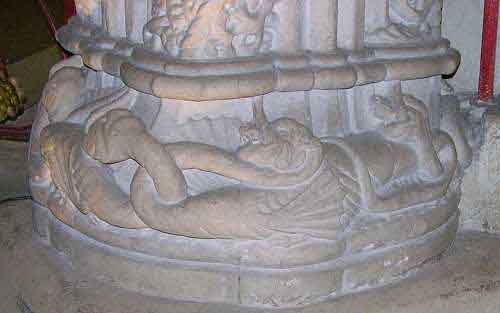
Rosslyn Chapel, or the Collegiate Chapel of St Mathew as it was to have been, was founded in 1446 by Sir William St Clair, third and last St Clair Prince of Orkney. It is in fact only part of the choir of what was intended to be a larger cruciform building with a tower at its centre.
More than thirty-seven collegiate churches were built in Scotland between the reigns of James I and James IV (1406-1513). They were secular foundations intended to spread intellectual and spiritual knowledge, and the extravagance of their construction depended on the wealth of their founder.
After Sir William died in 1484, he was buried in the unfinished Chapel and the larger building he had planned was never completed. But the foundations of the nave are said to have been excavated in the nineteenth century and found to extend ninety-one feet beyond the Chapel's original west door, under the existing baptistry and churchyard.
What was built however is extraordinary enough, 'This building, I believe, may be pronounced unique, and I am confident it will be found curious, elaborate and singularly interesting, impossible to designate by any given or familiar term' wrote Britton on his Architectural Antiquities of Britain (1812), adding somewhat despairingly that its 'variety and eccentricity are not to be defined by any words of common acceptation.'
The principal authority on the history of the Chapel and the St Clair family is Father Richard Augustine Hay, Canon of St Genevieve in Paris and Prior of St Piermont. He examined historical records and charters of the St Clairs and completed a three volume study in 1700, parts of which were published in 1835 as A geneologie of the Sainteclaires of Rosslyn. His research was timely, since the original documents subsequently disappeared.
Of the founder Father Hay said this:
Sir William's son and successor to the Barony of Rosslyn, Sir Oliver St Clair, roofed the choir with its stone vault but did no more to fulfil his father's original design.
The Chapel was generously endowed by the founder, with provision for a provost, six prebendaries and two choristers, and in 1523 by his grandson, also Sir William, with land for dwelling houses and gardens.
On February 26,1571, however, just forty-eight years after his last endowment, there is a record of the provost and prebendaries resigning because of the endowments being taken by 'force and violence' into secular hands as the effects of the Reformation took hold.
The Presbytery records of Dalkeith reveal that in 1589 William Knox, brother of John Knox and minister of Cockpen, was censured 'for baptizing the Laird of Rosling's bairne' in Rosslyn Chapel, which was described as a 'house and monument of idolatrie, and not ane place appointit for teiching the word and ministratioun of ye sacrementis'.
The following year, the Presbytery forbade Mr George Ramsay, minister of Lasswade, from burying the wife of a later Oliver St Clair in the Chapel. The St Clairs had not yet succumbed to the Reformation and remained Roman Catholics.
This Oliver St Clair was repeatedly warned to destroy the altars in the Chapel and in1592 was summoned to appear before the General Assembly and threatened with excommunication if the altars remained standing after August 17th, 1592. On August 31st, the same George Ramsay reported that 'the altars of Roslene were haille demolishit'. From that time the Chapel ceased to be used as a house of prayer and soon fell into disrepair.
In 1650, during the Civil War, Cromwell's troops under General Monk attacked the castle and his horses were stabled in the Chapel.
On December 11th, 1688, shortly after the protestant William of Orange had landed in England and displaced the Catholic James II, a mob from Edinburgh and some of the villagers from Roslin entered and damaged the Chapel. Their object was to destroy the furniture and vestments, which were now regarded as Popish and idolatrous.
The Chapel remained abandoned until 1736, when St James St Clair glazed the windows for the first time, repaired the roof, and relaid the floor with flagstones. The boundary wall was also built at this time.
When Dorothy Wordsworth visited the Chapel on September 17th, 1807, she remarked: 'Went to view the inside of the Chapel of Roslyn, which is kept locked up, and so preserved from the injuries it might otherwise receive from idle boys, but as nothing is done to keep it together, it must, in the end, fall. The architecture within is exquisitely beautiful.'
Further repairs to the Chapel were undertaken at the beginning of the nineteenth century and in 1861 it was agreed by James Alexander, 3rd Earl of Rosslyn, that Sunday services should begin again. He instructed the Edinburgh architect David Bryce to carry out restoration work. The carvings in the Lady Chapel were attended to, stones were relaid in the crypt and an altar established there. The Chapel was rededicated on Tuesday April 22nd, 1862, by the Bishop of Edinburgh and the Bishop of Brechin preached from the text, 'Our Lord, I have loved the habitation of thy house, and the place where thine honour dwelleth'.
The Reverend R. Cole, then resident military chaplain at Greenlaw Barracks near Penicuick, became private chaplain to the Earl. Lady Helen Wedderburn, daughter of the 7th Earl of Airlie, who lived nearby at Rosebank, organised a subscription from which some of the interior fittings were provided.
In 1880-1, Francis Robert, 4th Earl of Rosslyn, added the apse to serve as a baptistry with an organ loft above. The work is by Andrew Kerr. The Earl also filled the baptistry arch with the handsome oak tracery which you see today, decorated with his crest. Together with the two Chapel doors, this is the only wood used in the construction of the building.
The cost of the work was seven hundred and fifty eight pounds, eight shillings and six pennies, with a further thirty four pounds and eighteen shillings to Andrew Kerr for fees. Kerr told the Earl that a party of visitors 'had remarked that it was wonderful that such young men should be entrusted to execute such carving,' to which the estate factor 'very coolly replied, that it was not wonderful here, as the finest pillar in the Chapel was the work of an apprentice boy.'
The Earl was happy with the work and in a letter to Kerr on November 16th, wrote: ' I must say that the author pronounces your building a complete success.'
In 1915, a report on the fabric by Sir Robert Lorimer observed: ' The stone work of the Chapel is in fairly good order and requires very little done to it... a few of the stones are crumbling but not to the extent to cause any alarm. The condition of the roof is not satisfactory... and there are a number of gaps and cracks all over.' He recommended that the exterior of the roof be covered with asphalt and this was carried out.
In 1942 the Chapel was almost closed for a second time when a government official called Robertson wrote to the Minister of Labour, Ernest Bevin MP, 'that the Episcopalian Church at Roslin was almost empty every Sunday... on a recent Sunday there was a congregation of only two, and apart from the Clergyman's labour there must be other workers employed in cleaning and looking after the church and I suggest that steps are taken to close it down.'
A copy of the letter was sent to Gwilym Lloyd George MP, the Minister of Fuel, who in turn wrote to the Secretary of State for Scotland in the following terms; 'I enclose a copy of a letter from David Robertson which causes me considerable embarrassment, who am I, a Welshman, that I should do anything that might imperil the eternal salvation of one Scottish Episcopalian. In any case, from the fuel point of view, I doubt whether I would be justified in securing a small economy of fuel in this world at the possible cost of a disproportionate expenditure of it on myself in the next.' The Chapel remained open.
Further work was carried out by Anthony 6th Earl of Rosslyn, in the 1950's when the crypt roof was repaired and the interior carvings cleaned by hand over a period of several years. He also added the stained glass windows in the baptistry. A report of May 1954 from the Ancient Monuments Branch of the Ministry of Works records that 'surfaces covered with green algae will be scrubbed down with stiff bristle brushes... using a solution of .880 ammonia and water. Water will then be used copiously until the surfaces are clean and free from dirt and vegetation. Flaky patches will be sealed off... Hollow areas in ornament will receive special treatment by grouting... and when the surfaces are thoroughly dry they will be hardened with silica fluoride of magnesium at a rate of 1lb per two gallons of water.'
This work was in accordance with the thinking of the time but not, unfortunately, with current conservation philosophy. The effect of the magnesium fluoride - a cementitious slurry - was to seal the internal surface of the masonry with an impermeable coating, so that the stone became saturated with water containing soluble pollutants. In addition, the coldness of the wet stone encouraged condensation. A report in 1995 confirmed that damage was occurring and that humidity in the Chapel was very high. It recommended that steps should be taken to dry out the saturated masonry, remove if possible the cementitious coating, and restore the permeability of the richly carved inner surfaces of the Chapel.
In March 1997, a free-standing steel structure was erected to cover the Chapel. It will enable the stone fabric of the roof vaults to dry outwards, away from the carved interior surfaces. In due course the bituminous felt, asphalt and concrete coverings of the stone roof vaults will be removed to assist this process. Stone and mortar repairs to the external walls, pinnacles, and buttresses, renewal of the rainwater disposal arrangements, repairs to the stained glass, and appropriate repair and conservation of the interior are all required. The coverings over the stone vaulted roofs will be renewed in lead and ways of removing the cementitious slurry are being investigated, in order that this magnificent building can be preserved for future generations to use and admire.
The year 2000 saw the Trust embark on a second phase of work. Funded jointly by The National Heritage Lottery Fund, The Eastern Scotland European Partnership, Historic Scotland and the Rosslyn Chapel Trust, this phase has a number of elements. Essential stabilization works to the east boundary walls will protect the Chapel. A new roof of Caithness slate has been placed over the existing Crypt roof, and the Priest's Cell and two more modern buildings beside the Crypt have been made functional. The stairs to the Crypt have been repaired and the access to the Crypt is now both safer and more of an experience. Work has also been carried out to improve the electrical services in the Chapel, repairs to the wooden screen at the west end, and our interpretation of Rosslyn's story.
Reference: Rosslyn Chapel Website
Rosslyn Chapel, originally named the Collegiate Chapel of St. Matthew, is a 15th Century church in the village of Roslin, Midlothian, Scotland. The chapel was designed by William Sinclair of the St. Clair family, a Scottish noble family descended from Norman knights and, according to legend, linked to the Knights Templar. Construction of the chapel began in 1440, and the chapel was officially founded in 1446. Construction lasted for forty years.
Some authors have theorized that the Chapel's west wall is actually a model of the Wailing Wall in Jerusalem and is part of the structure by design, rather than proof of another intended stage of building, which would have made the site about the size of a Cathedral.
The chapel has long been famous for its possible connections to Freemasonry and its attendant rituals. This was first publicized by Knight and Lomas, but it is also found in works by Michael Baigent and Leigh and Tim Wallace Murphy (circa 1990), and the connections entered mainstream consciousness when named in the novel The Da Vinci Code for its (possible) links to the Holy Grail.
Despite the fictitious nature of this work, its influence has been considerable. The Scottish NGO The Friends of Rosslyn, which own the land surrounding the Chapel and the Rosslyn Chapel Trust which administers the Chapel, have both published a number of books and literature on the Chapel.
Certainly the Chapel is used by the modern Knights Templar (a masonic group rather than descendants of the military religious order) for 'investiture' ceremonies, and because of its connection to one of the more famous freemasons (William Sinclair) and also due to the Masonic architecture and symbolism featured on the Chapel walls, many Freemasons from all over the world visit it. Certain points in its architecture are quite indicative of a Masonic, and Templar, connection.
In addition to the theory that the Chapel was used by Freemasons and Knights Templar is the claim that those groups, stationed at Rosslyn Chapel, journeyed to North America and back before Columbus. This claim is based on several points:
2. the Westford Knight is a rock engraving in Massachusetts supposedly showing a Scottish knight, linked to the Henry Sinclair party, with the Clan Gunn markings;
3. most importantly, Rosslyn Chapel, although completed six years before Columbus' voyage, allegedly has stone carvings in it of plants unique to the Western hemisphere.
Because of its rumored connections with Freemasonry, the chapel has inevitably become listed as one of the possible final resting places of The Holy Grail. This is a possibility based on legends of 'Secret Vaults' and the possibility that the similarities between Rosslyn and the Temple of Jerusalem might be more than cosmetic.
The White Lady of Rosslyn Castle is said to hide a secret worth 'millions of pounds' - and some have suggested that this could be The Grail or instructions on how to find it.
St Clair legend suggests that there are three big medieval chests (probably the size of steamer trunks) buried somewhere on the property, and this has inevitably led to various theories as to the chests' contents. Past scanning and excavations in or near the Chapel have not yielded any such chests.
Sealed chambers under the basement of the chapel, however, have yet to be excavated for fear of collapse of the entire structure.
These chambers are filled with pure white Arabic sand -- rumored to have been brought to the chapel by the Knights Templar from the Dome of the Rock -- and ultrasonic scans have revealed six leaden vaults within the sand.
It should be noted that it is only the Ruined Wall that is based on the Temple of Jerusalem - the chapel itself most closely resembles the East Quire of Glasgow Cathedral.
The Chapel is famous for its two pillars: the Apprentice Pillar and the Master Pillar which, though next to each other, are carved differently. Masonic Architects believe these structures could signify the pillars of Boaz and Jachin.
Most interestingly are the (pictorial) references to the Key of Hiram, a significant piece of Masonic legend in the wall carvings, and in depictions of the New World, purportedly showing maize and aloe vera plants about a century before the discovery of North America, suggesting pre-Columbus travel there (the La Merika theory).
Also many archaeoastronomers believe that the walls are carved with azimuths, that give co-ordinates for sites in Iceland (where the St. Clairs supposedly originated) and across Britain.
References:
M.Oxbrow & I. Robertson. Rosslyn and the Grail Mainstream Publishing, 2005.
Christopher Knight and Robert Lomas. The Hiram Key
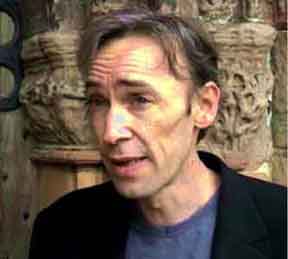
Stuart Mitchell and the Roslyn Motet
MYSTERY SCHOOLS AND SECRET SOCIETIES